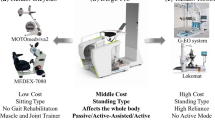Abstract
The present study focused on the gait training algorithm of an end-effector typed hybrid walking rehabilitation robot that our research group developed in 2017. One motor and five link mechanism in the end-effector typed hybrid walking rehabilitation robot were used to mimic normal gait patterns. Depending on patients’ condition and training difficulty, three gait rehabilitation training modes were proposed. Mode 1 is a passive mode that motor leads to patients’ walking entirely, Mode 2 is an assisted-active mode that a part of patients’ muscle strength were supported depending on their walking intention, and Mode 3 is an active mode that patients walk on their own muscle strength under gait resistance by eddy current brake. At each training mode, patients’ muscle strength performance by driving motor was experimentally verified using electromyography. In addition, gait symmetry between injured limb and uninjured limb improved as evidenced by motion capture analysis using inertial measurement unit.


















Similar content being viewed by others
References
Kim, K. E., Park, W. B., Oh, M. K., Kang, E. K., Lim, J. Y., Yang, E. J., et al. (2010). The effect of physical performance and physical activity on quality of life in old people: The Korean longitudinal study on health and aging. Annals of Geriatric Medicine and Research, 14(4), 212–220.
Kelly-Hayes, M. (2010). Influence of age and health behaviors on stroke risk: Lessons from longitudinal studies. Journal of the American Geriatrics Society, 58(S2), S325–S328.
Reeve, A., Simcox, E., & Turnbull, D. (2014). Ageing and Parkinson’s disease: Why is advancing age the biggest risk factor? Ageing Research Reviews, 14, 19–30.
Thorsén, A. M., Holmqvist, L. W., de Pedro-Cuesta, J., & von Koch, L. (2005). A randomized controlled trial of early supported discharge and continued rehabilitation at home after stroke five-year follow-up of patient outcome. Stroke, 36, 297–302.
Bernhardt, J., Dewey, H., Thrift, A., Collier, J., & Donnan, G. (2008). A very early rehabilitation trial for stroke (AVERT) phase II safety and feasibility. Stroke, 39, 390–396.
Belda-Lois, J. M., Horno, S. M., Bermejo-Bosch, I., Moreno, J. C., Pons, J. L., Farina, D., et al. (2011). Rehabilitation of gait after stroke: A review towards a top-down approach. Journal of NeuroEngineering and Rehabilitation, 8, 66.
Eng, J. J., & Tang, P. F. (2007). Gait training strategies to optimize walking ability in people with stroke: A synthesis of the evidence. Expert Review of Neurotherapeutics, 7(10), 1417–1436.
Ko, C. Y., Ko, J. W., Kim, H. J., & Lim, D. H. (2016). New wearable exoskeleton for gait rehabilitation assistance integrated with mobility system. International Journal of Precision Engineering and Manufacturing, 17(7), 957–964.
Hidler, J., Brennan, D., Black, I., Nichols, D., Brady, K., & Nef, T. (2018). Master–slave control of an intention-actuated exoskeletal robot for locomotion and lower extremity rehabilitation. International Journal of Precision Engineering and Manufacturing, 19(7), 983–991.
Hidler, J., Brennan, D., Black, I., Nichols, D., Brady, K., & Nef, T. (2011). ZeroG: Overground gait and balance training system. Journal of Rehabilitation Research and Development, 48(4), 287–298.
Jezernik, S., Colombo, G., Keller, T., Frueh, H., & Morari, M. (2003). Robotic orthosis lokomat: A rehabilitation and research tool. Neuromodulation, 6(2), 108–115.
Kim, S. Y., Yang, L., Park, I. J., Kim, E. J., JoshuaPark, M. S., You, S. H., et al. (2015). Effects of innovative WALKBOT robotic-assisted locomotor training on balance and gait recovery in hemiparetic stroke: A prospective, randomized, experimenter blinded case control study with a 4-week follow-up. IEEE Transactions on Neural Systems and Rehabilitation Engineering, 23(4), 636–642S.
Hesse, A., & Waldner, C. Tomelleri. (2010). Innovative gait robot for the repetitive practice of floor walking and stair climbing up and down in stroke patients. Journal of Neuroengineering and Rehabilitation, 7, 30.
Kim, J. J., Kim, M. J., Kwak, N. S., Kim, C. H., Kim, H., & Kim, J. Y. (2018). Development of an end-effector typed walking rehabilitation robot capable of power assistance. Transactions of the Korean Society of Mechanical Engineers - A, 42(8), 721–730.
Mehrholz, J., Wagner, K., Rutte, K., Meibner, D., & Pohl, M. (2007). Predictive validity and responsiveness of the functional ambulation category in hemiparetic patients after stroke. Archives of Physical Medicine and Rehabilitation, 88, 1314–1319.
Hesse, S., Werner, C., Paul, T., Bardeleben, A., & Chaler, J. (2001). Influence of walking speed on lower limb muscle activity and energy consumption during treadmill walking of hemiparetic patients. Archives of Physical Medicine and Rehabilitation, 88(11), 1547–1550.
Gait training algorithm of an end-effector typed hybrid walking rehabilitation robot. (2019). https://youtu.be/K-YhacSxjZk. Accessed March 6, 2019.
Hsiao-Wecksler, E., Polk, J., Rosengren, K., Sosnoff, J., & Hong, S. (2010). A review of new analytic techniques for quantifying symmetry in locomotion. Symmetry, 2(2), 1135–1155.
Acknowledgements
This study was supported by the Translational Research Center for Rehabilitation Robots (NRCTR-EX17013). IRB No.: NRC-2017-04-029. In addition, this work was supported by Incheon National University (International Cooperative) Research Grant in 2018.
Author information
Authors and Affiliations
Corresponding author
Additional information
Publisher's Note
Springer Nature remains neutral with regard to jurisdictional claims in published maps and institutional affiliations.
Rights and permissions
About this article
Cite this article
Kim, JY., Kim, JJ. & Park, K. Gait Training Algorithm of an End-Effector Typed Hybrid Walking Rehabilitation Robot. Int. J. Precis. Eng. Manuf. 20, 1767–1775 (2019). https://doi.org/10.1007/s12541-019-00185-y
Received:
Revised:
Accepted:
Published:
Issue Date:
DOI: https://doi.org/10.1007/s12541-019-00185-y




